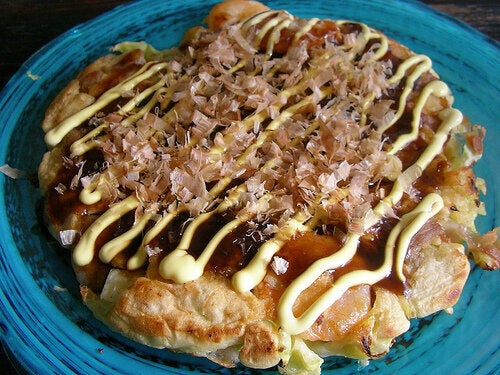
Americans know sushi. By now, we understand it. Raw fish of all types served with rice, wasabi, and seaweed in the Nigiri style or in rolls which wrap fish and vegetables inside the seaweed. In one west coast state, in particular, sushi is so popular that it launched its own "California Roll" - a roll featuring avocado and imitation crab instead of raw fish. While its most fervent aficionados would have no problem eating it every day, in Japan sushi is saved for special occasions. Sushi is hardly everyday fare in Japan.
In fact, Japanese cuisine offers much more than just the raw fish that has so enraptured us. And there's more than teriyaki and tempura too.
To start, there's perhaps the best kept secret of Japanese cuisine: Okonomiyaki. The word comes from two Japanese words meaning "what you like" and "cooked." This is Japan's take on the pancake--a savory dish of seafood, meat, and vegetables in a thick dough. The dough is typically made from flour, yam, egg, water and cabbage.
In the predominant style, purpoted to originate in Osaka, all of the ingredients are mixed together before the pancake is cooked. In Hiroshima style, the ingredients are layered rather than mixed and often include noodles in the pancake. In many restaurants, customers gather around griddles to make their own okonomiyaki. After the mixture is cooked, one usually adds the okonomiyaki sauce (similar to teriyaki sauce), and fish flakes. There are restaurants in Los Angeles, New York City, Atlanta, Seattle, St. Louis and other US cities that serve okonomiyaki, but they are much less frequent than sushi or even Japanese noodle shops.
Of course, the Japanese also eat a lot of noodles. The most popular are soba, a thin noodle made from buckwheat, and udon, a thicker noodle made from wheat flour. Both types of noodles can be served hot or cold. Chilled soba is often served on bamboo with a soba tsuyu dipping sauce. Hot udon noodles are immersed in a rich broth and topped with scallions and possibly fried fish, meat, or other vegetables. A soba dish has great versalitity, serving as a quick and cheap meal at Japanese train stations or as the main event in upscale restaurants. Udon is more common in western Japan, while soba is more prevalent in the east.
Chilled Soba Noodles
Hot Udon Noodles
Whichever type you choose, the important thing to remember is that slurping them is the norm, and considered a compliment. So feel free to make some noise while you eat!
Other dishes are meant to top off a bowl of white rice. Curry is one of the most popular meals in Japan. Japanese curry is usually thicker and sweeter than Indian curries. Unlike other curries, this one is usually made from a roux -- a mixture of flour and fat.
Another common dish with many variations is the donburi, literally a rice bowl dish. Donburi consist of rice topped with meat and vegetables. One type is oyakodon, a mixture of egg, onion, and chicken.
Oyakodon is sometimes referred to as the parent and child donburi, because it combines chicken and eggs in the same dish. Other donburi meals include Tekkadon, which tops rice with thinly sliced, raw tuna, and Tendon, with tempura shrimp and vegetables on top.
And for dessert? The Japanese do not typically enjoy the super-sweet dessert that so delight the American palate. Instead, many of Japanese desserts are flavored with anko, a red bean paste. Anko finds it way into sweet dumplings, buns, rice cakes, and much more. One of the popular desserts in the summer is green tea favored shaved ice served with anko and often topped with ice cream (In Japanese, this dish is called Uji- kintoki kakigori). The dish is served as a refreshing reprive from the heat and humidity of Japan's summers, which average 86 degrees Fahrenheit in Tokyo.
Japan may be a small country, but it offers an astounding variety of delectable dishes, from noodles to rice bowls to pancakes. While sushi may remain the most popular type of Japanese food in the West, there are many more avenues of rich Japanese cuisine to explore. So eat up!